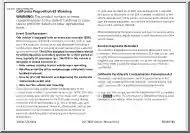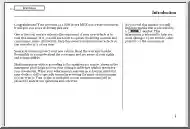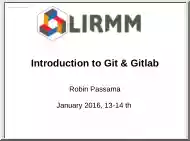No comments yet. You can be the first!
What did others read after this?
Content extract
Source: http://www.doksinet Pharmacology of serotonin actions Source: http://www.doksinet Serotonin or 5hydroxytryptamine Widely distributed amine (animals + plants) In humans, present in GI enterochromaffin cells (90%), platelets and brain. Synthesized from tryptophan (in diet) in two steps Can be blocked by p-chlorophenylalanine (PCPA; fenclonine) and by pchloroamphetamine (too toxic, not used in the clinical therapy) Platelets do not synthesize but take up from blood (active uptake process in platelets and nerve terminals, serotonin transporter mechanism (SERT)). Source: http://www.doksinet (Rate limiting) COOH C OH COOH Tryptophan hydroxylase NH2 C N NH2 N Tryptophan In diet. Active CNS transport C 5-Hydroxytryptophan 5-OH Tryptophan decarboxylase COOH OH H N C 5-Hydroxy Indole Acetic Acid NH2 N 5-OH Indole Acetaldehyde 5-Hydroxytryptamine Source: http://www.doksinet Serotonin synthesis and metabolization Source:
http://www.doksinet Synthesis and Metabolism Competition at the level of brain and neuronal uptake Rate limiting enzyme not saturated usually No end-product negative feedback 5-OHTr decarboxylase same as DOPA decarboxylase 5-OHIAA actively extruded from CNS (probenecid-sensitive) and excreted in urine. Source: http://www.doksinet Interference Inhibit uptake into CNS (other AA’s) Inhibit synthesis: p-chlorophenylalanine (irreversible) Inhibit neuronal re-uptake: cocaine, SSRA (e.g fluoxetine), TCA (eg imipramine) Inhibit storage-deplete: reserpine Inhibit metabolism: MAO inhibitors Non-selective Promote release: p-chloroamphetamine - then depletes (e.g fenfluramine to ↓ appetite) Source: http://www.doksinet Source: http://www.doksinet Source: http://www.doksinet Source: http://www.doksinet Serotonin Receptors At least 15 types and subtypes Multiple transduction mechanisms 5HT-1A: role in anxiety/depression
5HT-1D: role in migraine 5HT-2: role in CNS various behaviors, and in cardiovascular system 5-HT3: role in nausea and vomiting esp. due to Chemotherapy Source: http://www.doksinet Endogenous Function Central neurotransmitter Precursor of melatonin GI tract: motility (acting at 5-HT1B receptors, 5-HT initiates secretory and peristaltic reflexes), Stimulation of presynaptic 5-HT4 receptors amplifies neurotransmission in some enteric neurons, resulting in increased prokinetic activity in the gut, and may also play a part in the regulation of colonic motility. In carcinoid tumors: large amounts released leading to diarrhea, bronchoconstriction and edema Source: http://www.doksinet Blood vessels Large vessels, both arteries and veins, are usually constricted by 5-HT, although the sensitivity varies greatly. This is mediated through 5-HT2A receptors. Activation of 5-HT1 receptors causes constriction of large intracranial vessels. 5-HT can also cause
vasodilatation, partly by acting on endothelial cells to release nitric oxide and partly by inhibiting noradrenaline release from sympathetic nerve terminals. If 5-HT is injected intravenously, the blood pressure usually first rises, owing to the constriction of large vessels, and then falls, owing to arteriolar dilatation. Source: http://www.doksinet Platelets 5-HT causes platelet aggregation by acting on 5-HT2A receptors, and the platelets that collect in the vessel release further 5-HT. If the endothelium is intact, 5-HT release from adherent platelets causes vasodilatation, which helps to sustain blood flow; if it is damaged (e.g by atherosclerosis), 5-HT causes constriction and impairs blood flow further. These effects of platelet-derived 5-HT are thought to be important in vascular disease. Source: http://www.doksinet Nerve endings 5-HT stimulates nociceptive (pain-mediating) sensory nerve endings, an effect mediated mainly by 5-HT3 receptors.
If injected into the skin, 5-HT causes pain; when given systemically, it elicits a variety of autonomic reflexes through stimulation of afferent fibres in the heart and lungs, which further complicate the cardiovascular response. Nettle stings contain 5-HT among other mediators. 5-HT also inhibits transmitter release from adrenergic neurons in the periphery. Source: http://www.doksinet Serotonin Pharmacological Effects Respiratory system: bronchoconstriction if asthmatic; stimulation of aortic and carotid chemoreceptors ↑ RR and minute vol. GI tract: small intestine very sensitive to serotonin intense rhythmic contractions due to direct and indirect (ganglia in wall) effects. Also stimulates vomiting (5-HT3 receptors on vagal afferents and centrally). Source: http://www.doksinet Serotonin Pharmacological Effects -2 1. 2. 3. 4. Cardiovascular system: Multiple direct and indirect effects: Direct vasoconstriction (large arteries) and indirect
vasodilation (NO and PGI2 – mediated) Heart: direct inotropic and chronotropic effects Reflex mechanisms due to change in BP Stimulation of sensory nerve endings in baroreceptors and in vagal afferents in coronary circulation (Bezold Jarrisch reflex) bradycardia and hypotension Source: http://www.doksinet Serotonin in the Central Nervous System Pain perception Sleep/Wakefulness Various behaviors normal/abnormal: depression, schizophrenia, obsessive compulsive behavior, etc. Neuroendocrine regulation – controls hypothalamic cells involved in release of several anterior pituitary hormones. Source: http://www.doksinet Source: http://www.doksinet Pathogenesis of migrain Source: http://www.doksinet Migraine Clinical Presentations: Often accompanied by brief aura (visual scotomas, hemianopia) Severe, throbbing, usually unilateral headache (few hours to a few days in duration) Migraine Pathophysiology: Vasomotor mechanism -- inferred
from: increased temporal artery pulsation magnitude pain relief (by ergotamine) occurs with decreased artery pulsations Migraine attack associated with (based on histological studies): sterile neurogenic perivascular edema inflammation (clinically effective antimigraine medication reduce perivascular inflammation) Source: http://www.doksinet Migraine: Drug Treatment Ergotamine: best results when drug administered prior to the attack (prodromal phase) -- less effective as attack progresses combined with caffeine: better absorption potentially severe long-lasting Vasoconstriction. Dihydroergotamine (IV administration mainly): may be appropriate for intractable migraine Nonsteroidal antiinflammatory drugs (NSAIDs) Sumatriptan: alternative to ergotamine for acute migraine treatment; not recommended for patients with coronary vascular disease risk. formulations: subcutaneous injection, oral, nasal spray selective serotonin-receptor
agonist (short duration of action) probably more effective than ergotamine for management of acute migraine attacks (relief: 10 to 15 minutes following nasal spray) Source: http://www.doksinet Migraine: Prophylaxis Methysergide effective in about 60% of patients NOT effective in treating an active migraine attack or even preventing an impending attack. Methysergide toxicity: retroperitoneal fibroplasia, subendocardial fibrosis. Recommend 3-4 week drug holiday every six months Propranolol - Most common for continuous prophylaxis best established drug for migraine attack prevention. Amitriptyline (TCA) Valproic acid (Antiepileptic) most frequently used among the tricyclic antidepressants effective in decreasing migraine frequency. Nonsteroidal antiinflammatory drugs (NSAIDs) used for attack prevention and aborting acute attack Source: http://www.doksinet Serotonin in Migraine 1. 2. 3. 4. 5. Neurogenic vs.
Vascular theories Several drugs that modulate the serotonin system are effective in migraine: Cyproheptadine/methysergide prophylaxis Sumatriptan, ergotamine - acute MAO inhibitors and TCA – both Caffeine (↑ cAMP?) Reserpine worsens migraine Source: http://www.doksinet antidromic PAIN Unknown Trigger Activation Cortex Orthodromic conduction Thalamus Blood Vessel Trigeminal neuron autonomic nausea Mast cell Inhibitory receptor (5-HT1D) Trigem. Nucleus caudalis Source: http://www.doksinet Serotonin Agonists Sumatriptan: 5-HT1D agonist; contraindicated in patients with angina Fluoxetine: Selective serotonin uptake inhibitors for depression and other indications Buspirone: 5-HT1A agonist for anxiety Cisapride: 5-HT4 agonist to ↑ GI motility and decrease G-E reflux (Removed from US market due to fatal arrhythmias) LSD: 5HT1A – hallucinogen Ergot alkaloids: 5-HT1 and 2 and other Source: http://www.doksinet Serotonin Antagonists
Methysergide and Cyproheptadine. 5HT2 antagonists. In carcinoid, migraine. Ketanserin: 5HT2 and Alpha antagonist – used as antihypertensive. Ondansetron: 5-HT3 antagonist for chemotherapy induced nausea and vomiting Clozapine: 5HT2A/2C antagonist: for schizophrenia. Source: http://www.doksinet
http://www.doksinet Synthesis and Metabolism Competition at the level of brain and neuronal uptake Rate limiting enzyme not saturated usually No end-product negative feedback 5-OHTr decarboxylase same as DOPA decarboxylase 5-OHIAA actively extruded from CNS (probenecid-sensitive) and excreted in urine. Source: http://www.doksinet Interference Inhibit uptake into CNS (other AA’s) Inhibit synthesis: p-chlorophenylalanine (irreversible) Inhibit neuronal re-uptake: cocaine, SSRA (e.g fluoxetine), TCA (eg imipramine) Inhibit storage-deplete: reserpine Inhibit metabolism: MAO inhibitors Non-selective Promote release: p-chloroamphetamine - then depletes (e.g fenfluramine to ↓ appetite) Source: http://www.doksinet Source: http://www.doksinet Source: http://www.doksinet Source: http://www.doksinet Serotonin Receptors At least 15 types and subtypes Multiple transduction mechanisms 5HT-1A: role in anxiety/depression
5HT-1D: role in migraine 5HT-2: role in CNS various behaviors, and in cardiovascular system 5-HT3: role in nausea and vomiting esp. due to Chemotherapy Source: http://www.doksinet Endogenous Function Central neurotransmitter Precursor of melatonin GI tract: motility (acting at 5-HT1B receptors, 5-HT initiates secretory and peristaltic reflexes), Stimulation of presynaptic 5-HT4 receptors amplifies neurotransmission in some enteric neurons, resulting in increased prokinetic activity in the gut, and may also play a part in the regulation of colonic motility. In carcinoid tumors: large amounts released leading to diarrhea, bronchoconstriction and edema Source: http://www.doksinet Blood vessels Large vessels, both arteries and veins, are usually constricted by 5-HT, although the sensitivity varies greatly. This is mediated through 5-HT2A receptors. Activation of 5-HT1 receptors causes constriction of large intracranial vessels. 5-HT can also cause
vasodilatation, partly by acting on endothelial cells to release nitric oxide and partly by inhibiting noradrenaline release from sympathetic nerve terminals. If 5-HT is injected intravenously, the blood pressure usually first rises, owing to the constriction of large vessels, and then falls, owing to arteriolar dilatation. Source: http://www.doksinet Platelets 5-HT causes platelet aggregation by acting on 5-HT2A receptors, and the platelets that collect in the vessel release further 5-HT. If the endothelium is intact, 5-HT release from adherent platelets causes vasodilatation, which helps to sustain blood flow; if it is damaged (e.g by atherosclerosis), 5-HT causes constriction and impairs blood flow further. These effects of platelet-derived 5-HT are thought to be important in vascular disease. Source: http://www.doksinet Nerve endings 5-HT stimulates nociceptive (pain-mediating) sensory nerve endings, an effect mediated mainly by 5-HT3 receptors.
If injected into the skin, 5-HT causes pain; when given systemically, it elicits a variety of autonomic reflexes through stimulation of afferent fibres in the heart and lungs, which further complicate the cardiovascular response. Nettle stings contain 5-HT among other mediators. 5-HT also inhibits transmitter release from adrenergic neurons in the periphery. Source: http://www.doksinet Serotonin Pharmacological Effects Respiratory system: bronchoconstriction if asthmatic; stimulation of aortic and carotid chemoreceptors ↑ RR and minute vol. GI tract: small intestine very sensitive to serotonin intense rhythmic contractions due to direct and indirect (ganglia in wall) effects. Also stimulates vomiting (5-HT3 receptors on vagal afferents and centrally). Source: http://www.doksinet Serotonin Pharmacological Effects -2 1. 2. 3. 4. Cardiovascular system: Multiple direct and indirect effects: Direct vasoconstriction (large arteries) and indirect
vasodilation (NO and PGI2 – mediated) Heart: direct inotropic and chronotropic effects Reflex mechanisms due to change in BP Stimulation of sensory nerve endings in baroreceptors and in vagal afferents in coronary circulation (Bezold Jarrisch reflex) bradycardia and hypotension Source: http://www.doksinet Serotonin in the Central Nervous System Pain perception Sleep/Wakefulness Various behaviors normal/abnormal: depression, schizophrenia, obsessive compulsive behavior, etc. Neuroendocrine regulation – controls hypothalamic cells involved in release of several anterior pituitary hormones. Source: http://www.doksinet Source: http://www.doksinet Pathogenesis of migrain Source: http://www.doksinet Migraine Clinical Presentations: Often accompanied by brief aura (visual scotomas, hemianopia) Severe, throbbing, usually unilateral headache (few hours to a few days in duration) Migraine Pathophysiology: Vasomotor mechanism -- inferred
from: increased temporal artery pulsation magnitude pain relief (by ergotamine) occurs with decreased artery pulsations Migraine attack associated with (based on histological studies): sterile neurogenic perivascular edema inflammation (clinically effective antimigraine medication reduce perivascular inflammation) Source: http://www.doksinet Migraine: Drug Treatment Ergotamine: best results when drug administered prior to the attack (prodromal phase) -- less effective as attack progresses combined with caffeine: better absorption potentially severe long-lasting Vasoconstriction. Dihydroergotamine (IV administration mainly): may be appropriate for intractable migraine Nonsteroidal antiinflammatory drugs (NSAIDs) Sumatriptan: alternative to ergotamine for acute migraine treatment; not recommended for patients with coronary vascular disease risk. formulations: subcutaneous injection, oral, nasal spray selective serotonin-receptor
agonist (short duration of action) probably more effective than ergotamine for management of acute migraine attacks (relief: 10 to 15 minutes following nasal spray) Source: http://www.doksinet Migraine: Prophylaxis Methysergide effective in about 60% of patients NOT effective in treating an active migraine attack or even preventing an impending attack. Methysergide toxicity: retroperitoneal fibroplasia, subendocardial fibrosis. Recommend 3-4 week drug holiday every six months Propranolol - Most common for continuous prophylaxis best established drug for migraine attack prevention. Amitriptyline (TCA) Valproic acid (Antiepileptic) most frequently used among the tricyclic antidepressants effective in decreasing migraine frequency. Nonsteroidal antiinflammatory drugs (NSAIDs) used for attack prevention and aborting acute attack Source: http://www.doksinet Serotonin in Migraine 1. 2. 3. 4. 5. Neurogenic vs.
Vascular theories Several drugs that modulate the serotonin system are effective in migraine: Cyproheptadine/methysergide prophylaxis Sumatriptan, ergotamine - acute MAO inhibitors and TCA – both Caffeine (↑ cAMP?) Reserpine worsens migraine Source: http://www.doksinet antidromic PAIN Unknown Trigger Activation Cortex Orthodromic conduction Thalamus Blood Vessel Trigeminal neuron autonomic nausea Mast cell Inhibitory receptor (5-HT1D) Trigem. Nucleus caudalis Source: http://www.doksinet Serotonin Agonists Sumatriptan: 5-HT1D agonist; contraindicated in patients with angina Fluoxetine: Selective serotonin uptake inhibitors for depression and other indications Buspirone: 5-HT1A agonist for anxiety Cisapride: 5-HT4 agonist to ↑ GI motility and decrease G-E reflux (Removed from US market due to fatal arrhythmias) LSD: 5HT1A – hallucinogen Ergot alkaloids: 5-HT1 and 2 and other Source: http://www.doksinet Serotonin Antagonists
Methysergide and Cyproheptadine. 5HT2 antagonists. In carcinoid, migraine. Ketanserin: 5HT2 and Alpha antagonist – used as antihypertensive. Ondansetron: 5-HT3 antagonist for chemotherapy induced nausea and vomiting Clozapine: 5HT2A/2C antagonist: for schizophrenia. Source: http://www.doksinet




